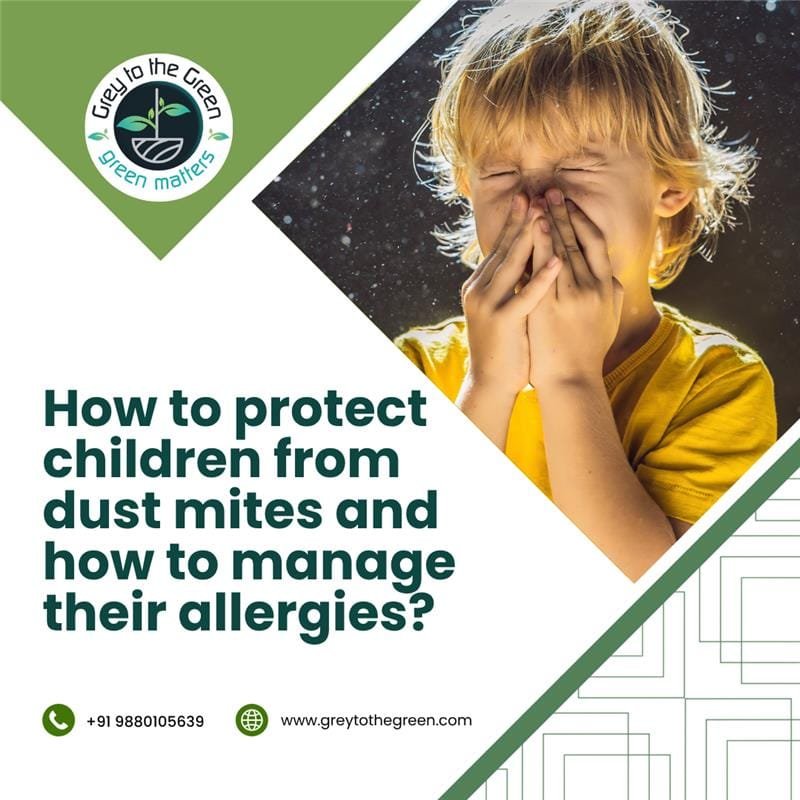Dust mite allergy is one of the most common yet underestimated health challenges faced by children today. These microscopic creatures lurk deep within our homes—in mattresses, pillows, carpets, and curtains—feeding on dead skin cells and thriving in humidity. While invisible to the naked eye, the impact of dust and dust mites can be felt strongly by children who are more sensitive to allergens. If your child frequently suffers from sneezing, rashes, nasal congestion, or asthma attacks, dust mite allergy could be the root cause.
In India, especially in humid cities like Bangalore, managing dust mite allergy becomes even more critical. High moisture levels, indoor pollutants, and lack of awareness make urban homes a breeding ground for these invisible pests. Fortunately, with the right knowledge and tools, you can protect your child and maintain a dust-mite-free environment.
Let’s explore how dust and dust mites affect your child’s health, how to recognize symptoms early, and how to prevent and manage dust mite allergy using safe, effective, and natural solutions.
What Is Dust Mite Allergy and Why Are Kids More Vulnerable?
Dust mite allergy is an allergic reaction triggered by the proteins in the waste and decomposed bodies of dust mites. Unlike seasonal allergies, dust mite allergies persist year-round, as dust and dust mites never go on vacation.
Children are particularly vulnerable to dust mite allergy for several reasons:
- Their immune systems are still developing.
- They spend more time indoors (especially in bed).
- Their respiratory tracts are more sensitive to airborne allergens.
- Frequent sneezing and runny noses
- Itchy, red, or watery eyes
- Eczema-like skin rashes
- Nasal congestion, postnasal drip
- Dry cough or wheezing at night
- Asthma flare-ups and difficulty breathing
If your child has been waking up with a stuffy nose or struggling with chronic skin issues, it might be time to consider dust mite allergy as a potential cause.
How Do Dust Mites Affect Health?
Dust mites are not dangerous by themselves—they don’t bite or sting. However, their feces and dead body fragments contain proteins that, when inhaled, trigger immune responses in sensitive individuals.
When your child breathes in these particles, their immune system treats them as harmful invaders and releases histamines. This response leads to the classic allergic symptoms we mentioned earlier.
Long-term exposure to dust mite allergy can lead to:
- Sleep disturbances
- Impaired focus and learning
- Worsening of asthma symptoms
- Infections due to constant nasal inflammation
Managing dust mite allergy early is crucial to ensuring that your child leads a healthy, active, and uninterrupted lifestyle.
Common Places Where Dust Mites Hide
Understanding where dust and dust mites hide is key to prevention. Common breeding grounds include:
- Mattresses and Pillows – The #1 dust mite hotspot due to warmth and skin flakes.
- Carpets and Rugs – Trap dust and humidity.
- Stuffed Toys – A favorite for both kids and mites!
- Curtains and Upholstery – Frequently ignored in cleaning routines.
- Bedsheets and Blankets – Absorb sweat and skin cells.
If your child is exposed to these items for long periods, it increases the risk of dust mite allergy.
How to Protect Children from Dust Mites and Manage Their Allergies
Dust mites are invisible but powerful triggers of allergies, especially in children. If your child suffers from frequent sneezing, runny nose, coughing, or skin irritation, dust and dust mites could be the culprit. Here’s how you can reduce their exposure and protect their health:
1. Keep Bedding Clean and Protected
Dust mites thrive in warm, humid bedding. Wash all bed linen weekly in hot water (above 60°C) to kill mites. Use allergen-proof covers on pillows, mattresses, and duvets to block mites from entering or escaping. Sun-dry blankets and mattresses whenever possible—the heat and UV rays naturally kill mites and reduce moisture.
2. Remove Dust-Collecting Decor
Heavy curtains, carpets, and stuffed toys attract dust. Replace curtains with washable blinds or sheer materials. Limit wall-to-wall carpeting and use washable rugs instead. Reduce stuffed toys in your child’s room or wash them weekly in hot water. For delicate toys, sealing them in a plastic bag and placing them in the freezer overnight can help kill dust mites.
3. Maintain Humidity Levels
Dust mites love humidity. Keep indoor humidity below 50% using a dehumidifier, especially in regions like Bangalore. Fix leaks, dry damp corners, and avoid drying wet clothes indoors, as these raise humidity and encourage mite growth.
4. Improve Indoor Ventilation
Open windows daily to let in fresh air and reduce stale, allergen-filled air. Ensure bathrooms, kitchens, and storage areas are well-ventilated and dry.
By combining these steps with a natural anti-dust mite spray like CheckMite, made from neem and US-EPA-approved ingredients, you can create a healthier, allergen-free space for your child—without exposing them to harmful chemicals.
Protect your children today. Say no to dust mite allergy and yes to cleaner, safer living.
Natural Defense: CheckMite Anti-Dust Mite Spray
Conventional cleaning methods like vacuuming or harsh chemicals are not always effective in eliminating dust mites. Worse, chemical sprays may trigger further allergic reactions in sensitive children.
Introducing CheckMite—a revolutionary anti-dust mite spray developed by Green to the Grey. This product is a safe, non-toxic, and eco-friendly solution specially designed for homes affected by dust mite allergy, particularly in high-risk regions like Bangalore.
Product Benefits:
- 100% Natural Ingredients: Contains neem and other plant-based actives with powerful insect-repelling properties.
- Safe for Children and Pets: No harmful chemicals or fumes.
- Clinically Certified & US-EPA Approved: Backed by science and safe for everyday use.
- Easy to Apply: Spray directly on beds, couches, curtains, toys, and carpets.
- Specifically Designed for Indian Climates: Highly effective in dusty, humid regions prone to dust mite allergy.
If you’re tired of seeing your child suffer despite regular cleaning, it’s time to try a solution that’s inspired by nature and approved by experts.
Why Neem Is the Star Ingredient
Neem has been used for centuries in traditional medicine and pest control. In the case of dust mite allergy, neem works in several ways:
- Antimicrobial: Kills bacteria and fungi that may accompany mite infestations.
- Insecticidal: Naturally repels dust mites without harming humans.
- Healing: Soothes irritated skin caused by mite-related allergies.
Unlike chemical pesticides, neem does not pollute indoor air, making it ideal for households with children.
How to Use CheckMite Anti-Dust Mite Spray
Managing dust mite allergy becomes simple with a quick daily routine:
Step-by-Step Guide:
- Shake the bottle well before use.
- Spray directly on pillows, mattresses, soft toys, carpets, and curtains.
- Let it dry naturally—no need to wipe off.
- Repeat every 2–3 days for best results.
Use it especially after cleaning, washing, or changing sheets to maintain an allergen-free zone for your child.
Real-Life Impact: Bangalore Families Fighting Back
In Bangalore, where dust mite allergy is on the rise due to high humidity and indoor pollutants, CheckMite is making a real difference.
Many parents have shared stories of how their children’s night-time coughing stopped, rashes faded, and overall mood improved just days after using CheckMite. A consistent routine has helped families reclaim their homes—and their peace of mind.
Common Mistakes to Avoid in Allergy Management
When dealing with dust mite allergy, beware of these common missteps:
- Using Room Fresheners or Fragranced Sprays: They mask the smell but worsen the allergy.
- Skipping Deep Cleaning of Mattresses and Toys: Surface cleaning is not enough.
- Over-Reliance on Air Purifiers Alone: Air purifiers help, but don’t remove mites from surfaces.
- Delaying Treatment: Early action prevents long-term damage to your child’s health.
A Natural Home Is a Healthy Home
Your child deserves to grow up in a space that supports their health and happiness. By eliminating hidden allergens like dust mites, you’re giving them a stronger immune system, uninterrupted sleep, and a better quality of life.
Choosing CheckMite means:
- Saying goodbye to unnecessary medications and doctor visits.
- Making your home a safe haven.
- Taking a stand against indoor pollution the natural way.
Conclusion: Your Anti-Allergy Action Plan Starts Today
If you’ve been battling dust mite allergy in Bangalore or anywhere in India, now’s the time to act. With tools like CheckMite’s anti-dust mite spray, you no longer have to rely on harsh chemicals or ineffective methods. Instead, you get a safe, effective, and eco-conscious solution that fits perfectly into a child-safe home.
Dust mites may be small, but the damage they cause can be massive. Don’t let them take over your child’s well-being.
Frequently Asked Questions (FAQs)
1. What is dust mite allergy?
Dust mite allergy is an allergic reaction caused by proteins in dust mite waste and dead bodies, triggering sneezing, rashes, and asthma.
2. Why are children more affected by dust mites?
Children have developing immune systems and spend more time indoors, making them more vulnerable to dust mite allergens.
3. How can I know if my child has a dust mite allergy?
Common symptoms include frequent sneezing, itchy eyes, nasal congestion, coughing, eczema-like rashes, and breathing issues.
4. Where do dust mites usually live?
Dust mites thrive in mattresses, pillows, carpets, curtains, and soft toys—anywhere that collects dust and dead skin.
5. How can I reduce dust mites at home?
Wash bedding weekly in hot water, use allergen-proof covers, reduce humidity, clean soft toys, and improve room ventilation.
6. Is CheckMite spray safe for children and pets?
Yes. CheckMite is made from neem and natural ingredients. It’s US-EPA-approved, non-toxic, and safe for everyday use.
7. How often should I use the CheckMite spray?
Spray every 2–3 days on beds, toys, carpets, and curtains. Use it after cleaning or changing bedding for best results.



